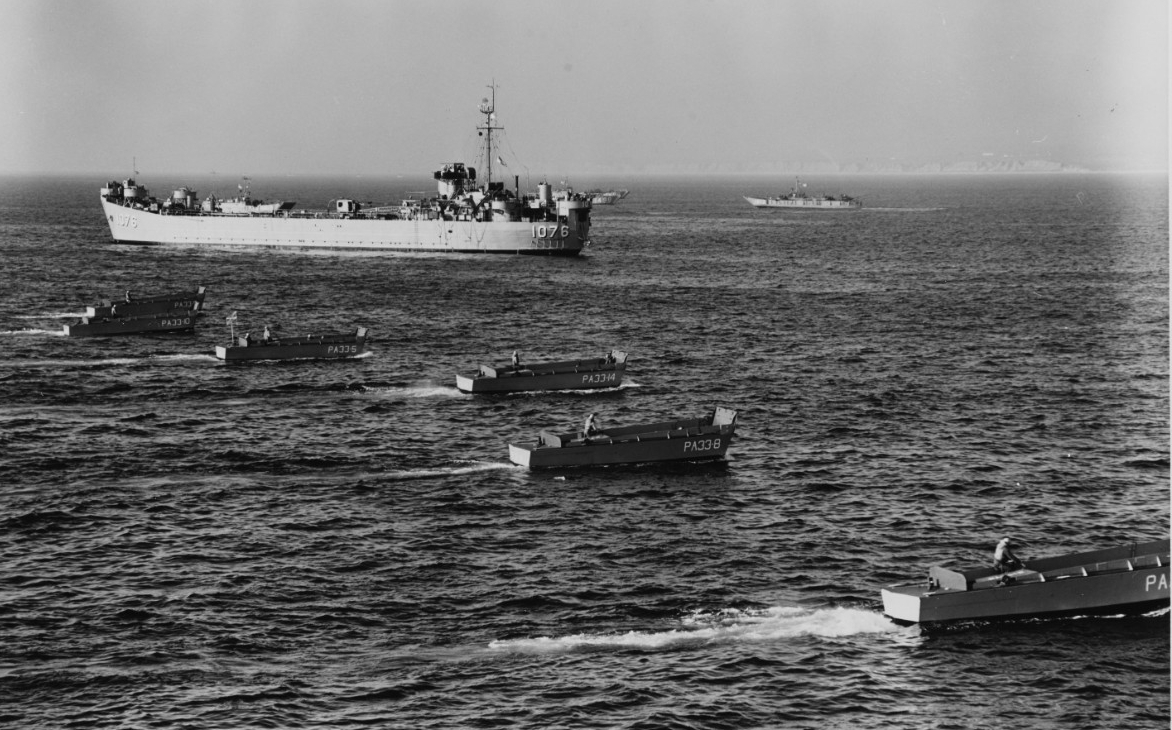Page County (LST-1076)
1955-1978
Counties in the states of Iowa and Virginia.
(LST-1076: displacement 4,080; length 328'0”; beam 50'0”; draft 14'1"; speed 11.6 knots; complement 119, troop capacity 147; armament 8 40 millimeter, 12 20 millimeter; class LST-542)
LST-1076 was laid down on 16 March 1945 at Hingham, Mass., by the Bethlehem Hingham Shipyard,; launched on 14 April 1945; sponsored by Mrs. Lillian J. Ostler; and commissioned on 1 May 1945, Lt. Grover L. Rawlings, D-V(G), USNR, in command.
After shakedown in Chesapeake Bay, LST-1076 embarked troops at New York, N.Y., and sailed on 14 June 1945 for Pearl Harbor, Territory of Hawaii. She reached her destination on 19 July and began several weeks of rigorous training in the Hawaiian operating areas, during which time Japan accepted the terms of the Potsdam Declaration and, on 14 August, agreed to surrender. LST-1076 stood out from Pearl on 29 August, with troops bound for Sasebo, Japan. She disembarked her passengers on 22 September and by 17 October was returning to the U.S. with war veterans.
LST-1076 reached San Diego, Calif., on 11 December 1945 and shortly thereafter went into overhaul. She was then sent to Vancouver, Wash., in April of 1946 for inactivation, and was decommissioned on 13 June and assigned to the Columbia Group of the U.S. Pacific Reserve Fleet.
Named Page County on 1 July 1955, the tank landing ship remained at Astoria, Oregon, in the Columbia River Group, until July 1960, when she was towed to San Diego for modernization and reactivation. Recommissioned on 28 November 1960, Lt. Cmdr. Lawrence J. Keily in command, Page County, following shakedown, carried out local operations off the coast of Southern California through 1961.

On 3 January 1962, Page County sailed for Pearl Harbor to provide logistic support for the U.S. Army. She operated within the Hawaiian Islands in support of the Army through January 1962 and shifted to operational control of Commander Hawaiian Sea Frontier on 1 February, for operations in the southern mid-Pacific. On 1 April she was assigned to Joint Task Force 8 in support of nuclear tests being conducted by the U.S. Government. She transported civilian construction crews and their equipment to islands such as Palmyra, Malden, Penrhyn, Washington, Fanning, and Christmas. She completed these assignments on 5 August and returned to San Diego on the 20th.
On 27 October 1962 Page County was called on to participate in the Cuban Crisis quarantine. She transited the Panama Canal on 8 November and reached Vieques, Puerto Rico, on the 16th. After shuttling troops between Roosevelt Roads and Vieques, she was detached on 1 December to return to San Diego.
Page County put into San Francisco on 16 March 1963 to undergo an extensive Mk. II FRAM [Fleet Rehabilitation and Modernization] overhaul which was completed in July. She returned to San Diego on 5 August and was assigned to coastal operations. Between 18 January and 16 February 1965, she participated in Operation Silver Lance, one of the largest Navy-Marine Corps training exercises ever held in peacetime. Deteriorating conditions in Vietnam, however, caused her immediate departure on 17 February, for Pearl Harbor, to transport elements of Marine Air Group 13 to Okinawa. She returned to San Diego on 7 May.
Page County deployed to Adak, Alaska (6 July--21 October 1965), returning to San Diego for coastal operations until 19 July 1966, when she prepared for second deployment to Vietnam. Operating principally between Chu Lai and Da Nang, she supported the struggle against Communist aggression in South Vietnam until returning to the U.S. in December.
Resuming local operations, Page County provided services to the Mine Force, Pacific (MinPac) in evaluating the capabilities of tank landing ships for minesweeping, and to Pacific Fleet Command for training exercises and administrative lifts for Hawaii-based Army and Fleet Marine Force units.
Early 1968 found Page County participating in exercises in the Eastern Pacific (EastPac), training marines based at Camp Pendleton, Calif., and Navy Construction Battalions (“Seabees”) based at Port Hueneme. During the spring, she again joined the Seventh Fleet for operations in Southeast Asia. From 11 September through 6 November, she operated out of Da Nang and returned to San Diego on 24 December, the day before Christmas, via Hong Kong, Yokosuka, and Pearl Harbor.
After operations on the West Coast, Page County returned to the Western Pacific in the autumn and served in the Seventh Fleet through the autumn of 1970, and was decommissioned on 5 March 1971.
Ultimately stricken from the Naval Vessel Register on 15 April 1978, Page County was transferred by cash sale under the Security Assistance Program to the government of Greece on 1 July 1978; she was renamed Kriti (L-171).
Page County received six engagement stars for her service during the Vietnam conflict.
Updated, Robert J. Cressman
5 January 2024


